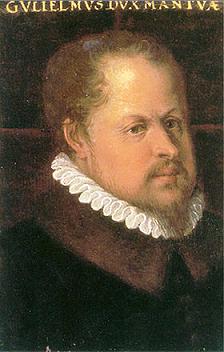
William I, Duke of Mantua
Encyclopedia

He was the second son of Federico II Gonzaga, Duke of Mantua and Margaret Palaeologina
Margaret Palaeologina
Margaret Palaeologa was an Italian ruler; Marchioness of Montferrat in her own right. She also married into the Gonzaga family, rulers of Mantua, making her Duchess of Mantua by her marriage to Federico II, Duke of Mantua...
of Montferrat.
In 1574, Montferrat was elevated to a Duchy
Duchy
A duchy is a territory, fief, or domain ruled by a duke or duchess.Some duchies were sovereign in areas that would become unified realms only during the Modern era . In contrast, others were subordinate districts of those kingdoms that unified either partially or completely during the Medieval era...
and he became its first duke. He was succeeded by his son Vincenzo.
Patron of music
Guglielmo was particularly interested in sacred vocal music, and is known particularly to music historians for his extensive correspondence with the composter Giovanni Pierluigi da PalestrinaGiovanni Pierluigi da Palestrina
Giovanni Pierluigi da Palestrina was an Italian Renaissance composer of sacred music and the best-known 16th-century representative of the Roman School of musical composition...
. He built a large new church in Mantua, dedicated to Santa Barbara. He engaged in an unprecedented negotiation with the Papacy to create his own rite for Mantua, and devoted considerable resources to developing a musical repertoire for the church, commissioning works by Giaches de Wert
Giaches de Wert
Giaches de Wert was a Franco-Flemish composer of the late Renaissance, active in Italy. Intimately connected with the progressive musical center of Ferrara, he was one of the leaders in developing the style of the late Renaissance madrigal...
and Palestrina. Part of his correspondence with Palestrina discusses the work commissioned in detail, stipulating Guglielmo's requirements, and therefore giving a sense of his musical preferences. Guglielmo's musical tastes were conservative for the day. He enjoyed imitative contrapuntal music but was concerned to maintain clarity of text, thereby showing the influence of Tridentine
Council of Trent
The Council of Trent was the 16th-century Ecumenical Council of the Roman Catholic Church. It is considered to be one of the Church's most important councils. It convened in Trent between December 13, 1545, and December 4, 1563 in twenty-five sessions for three periods...
reforms. Upon his death, his son Vincent invited followers of the more modern trends to his court. http://www.musicweb-international.com/classrev/2004/Dec04/monteverdi_madrigals3.htm
Marriage and children
On April 26, 1561, William married Eleonora of AustriaEleonora of Austria
Archduchess Eleanor of Austria was the daughter of Ferdinand I, Holy Roman Emperor and Anna of Bohemia and Hungary.-Family:...
, sixth daughter of Ferdinand I, Holy Roman Emperor
Ferdinand I, Holy Roman Emperor
Ferdinand I was Holy Roman Emperor from 1558 and king of Bohemia and Hungary from 1526 until his death. Before his accession, he ruled the Austrian hereditary lands of the Habsburgs in the name of his elder brother, Charles V, Holy Roman Emperor.The key events during his reign were the contest...
and Anna of Bohemia and Hungary
Anna of Bohemia and Hungary
Anna of Bohemia and Hungary, also sometimes known as Anna Jagellonica was, by marriage to Ferdinand I, King of the Romans and later Holy Roman Emperor, Queen of the Romans.-Family:She was the elder child and only daughter of king Vladislaus II of Bohemia and Hungary and his third...
. They were parents to three children:
- Vincenzo I (21 September 1562 – 9 February 1612).Married Eleonora de' MediciEleonora de' MediciEleonora de' Medici was the eldest child of Francesco I de' Medici and Johanna of Austria. She was a family member of the famous House of Medici.-Family:...
(Eleanor's niece). - Margherita GonzagaMargherita Gonzaga d'EsteMargherita Gonzaga d'Este, Duchess of Ferrara was an Italian noblewoman, the daughter of William I, Duke of Mantua and Eleonora of Austria, and the sister of Vincent I, Duke of Mantua and Anna Caterina Gonzaga. She was the wife of Alfonso II d'Este, Duke of Ferrara and Modena, whom she married...
(27 May 1564 – 6 January 1618). Married Alfonso II d'Este. - Anna Caterina GonzagaAnne Juliana GonzagaAnne Catherine Gonzaga, O.S.M. was an Archduchess of Austria who went on to become a Servant of Mary upon the death of her husband, the Archduke Ferdinand II of Austria.-Biography:...
(17 January 1566 – 3 August 1621). Married her maternal uncle Ferdinand II, Archduke of AustriaFerdinand II, Archduke of AustriaFerdinand II, Archduke of Further Austria was ruler of Further Austria including Tirol.-Life account:...
.

